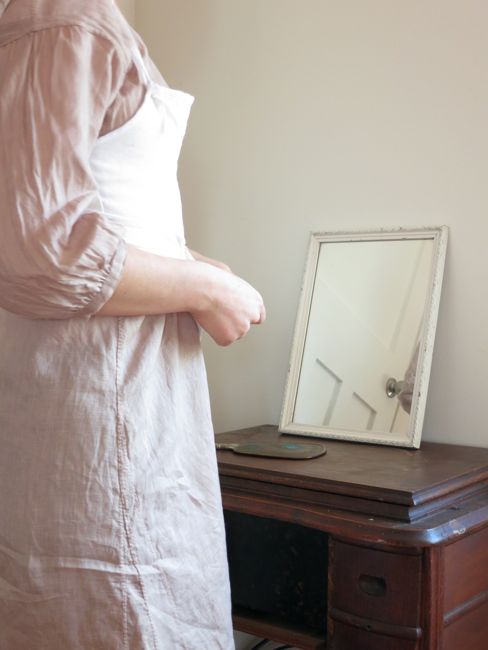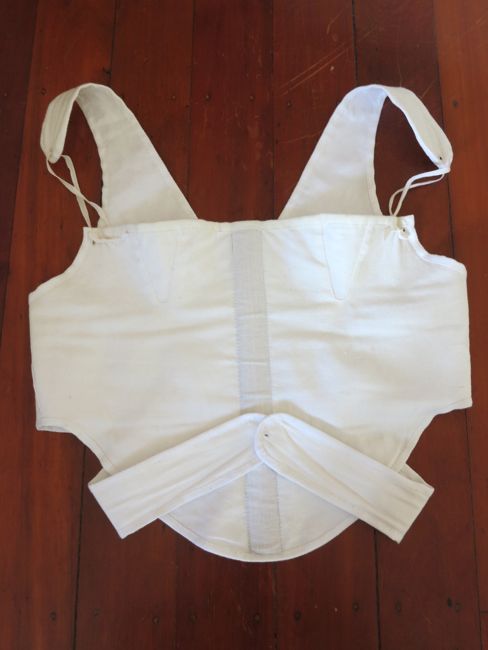A month ago Sabine came out with Short Stays Studies 2.0, and a new short stays pattern based on a pair of wrapped short stays (corset a la paresseuse – corset for the lazy) she identified at Centraal Museum, Utrecht. Cue massive excitement.
So much excitement, that the very day she published her research, I downloaded the pattern, scaled it up to my measurements based on her guidelines, and printed it out. The pattern was very well drafted – super easy to scale up, and very easy to put together.
Then I did a quick toile, tried it on, and voilà – super easy impressive uplift!
I made a few tiny changes to the pattern based on my toile – longer shoulder straps (not nearly long enough as it turned out), rounded edges to all the straps, and eyelets to lace through and fasten the front wrap, rather than a hook, so the stays would be more adjustable for size (Sabine even suggests that ties rather than hooks may have been how the stays originally fastened).
With the toile sorted I cut out the corset (with the lack of boning, these really were probably called corsets not stays) pieces – one layer in glazed cotton, one layer in midweight raime. Gussets, side seams, eyelets, and then lots, and lots, and lots, and lots, and lots of binding.
They took way longer than expected, thanks to my flu and all that binding (why does sewing binding take so long?), so they were finished today – just in time for the Shape and Support HSF challenge.
Unfortunately, this is what they look like:
The falling off the shoulder isn’t a pattern problem – everything falls off my shoulder – I have scoliosis and am seriously lopsided. The bust though, that’s an issue:
The bust, despite using the exact same gussets that worked so well in my toile, gapes terribly.
And it doesn’t provide any real uplift. My bust keeps trying to slip down, so the gussets sit halfway up the bust. Ouch.
The back wrap looks great though, even in blurry, terrible, self-timer photos:
Other than the back though, not a success. So, grumpy, grumpy dreamstress. I had a play to see if I could improve things (without having to take out and re-do the gussets).
First quick fix: I worked a second pair of lacing holes where the straps attach at the bust, so that the straps would be more secure, less likely to slip off my shoulders, and would provide more lift for my bust:
Then I remembered that I’d fitted the toile over a modern singlet, not a chemise. Would that make a difference?
As a matter of fact, yes! Massive improvement. Uplift, cleavage, high round bosom. (Well, more uplift, cleavage, and high round bosom than usual. I don’t have a lot to work with.) Unfortunately, wearing the stays with a knit singlet certainly isn’t period! I shouldn’t have cheated and fitted my toile over one.
I’m still not particularly impressed with how they fit my body though, and unfortunately they aren’t very comfortable. The straps dig into my shoulders, and the wrap gives me a backache.
I think these are a really interesting garment, but for me, they didn’t work particularly well.
I could probably improve them a bit with pattern alterations, particularly to the gusset area, but some of the biggest problems are simply the result of my figure, and can’t be corrected. Anything that wraps that tightly across my lower ribs is going to hurt and exacerbate my scoliosis.
The search for Regency corsets/stays that are comfortable and provide me with the right shape continues. Time to to try Sabine’s other Regency Short Stays patterns, and some of the other Regency patterns out there!
They do look good laid flat though:
The Challenge: #12 — Shape & Support
Fabric: 1/2 metre polished cotton, 1/2 metre raime
Pattern: Sabine of Kleidung um 1800s corset a la Paresseuse pattern, based on an original at the Centraal Museum
Year: 1805-20
Notions: Cotton twill tape in 3 sizes, linen and cotton thread, one wooden ruler.
How historically accurate is it? I followed the pattern very closely, but scaled it up to my measurements. My materials are reasonably period accurate (though the ramie would have been nettle cloth), and they are entirely hand sewn. My alterations are all in line with what might have been done in period (and Sabine even mentions that the corset may have originally tied, not hooked). So 90%
Hours to complete: 9 hours
First worn: For photos. Unless I find a model that fits it better than I, it’s unlikely to see much use, because backache: Owww!
Thank you so much Sabine for the pattern and research! I’m gutted that my version isn’t really working on me, but enjoyed making them and the hand-on research nonetheless.














Thank you very much for trying out the pattern from the extant Utrecht stays! Every input on how it works for different body shapes is highly interesting and will help to create a picture of how stays (Schnuerleib) have been worn and developed in period.
Rather than the women two centuries ago, we certainly tend to look for the ‘one pair of stays or corset’, which works comfortably for all purpose in today’s re-creation/re-enactment/historical costuming (as we usually do not wear the clothes 24 hours/day and each day of the year).
Back in period those women, who could monetarily afford, would choose a different set for different occasions. The ‘paresseuse’ have been designed or assembled to fulfill the needs during informal occasions like morning attire or during a travel only.
There are a few possibilites to give more ease with these stays, like instead of crossing the straps quite low and close them on stomach level, the straps could be patterned horizontal that one strap will lead through a slit in one side seam and they are then closed directly under the bust. I didn’t have time to have an attempt on that version, but it might work better for you.
In J.S. Bernhardt’s book is a whole chapter on working stays for different shapes, medical requirements and needs, I do hope that somewhere in the future I manage to work on these stays and the texts.
As period underwear lacked the flexibility in fabric like modern bras have, it’s always a lot of trial and error to find the pair, which works best as each body is different and one of a kind.
Thank you again for connecting with the past via and extant pair of stays and sharing your results 🙂
Thanks Sabine – both for the pattern and the comments! I definitely understood this was an informal wear pattern, but under any circumstances it wouldn’t work for me. It’s like trying on a sports bra that pinches and tugs – you know it isn’t a regular bra, but it still doesn’t fit like a sports bra should! I do have a somewhat unusual body in that I have scoliosis – curvature of the spine. Most corsets are really good for me, because they pull my spine into shape, but something very tight and wrap-y pulls it into a worse spiral, as I’ve found.
I have scoliosis, too, along with uneven shoulders (exacerbated by carrying a diaper bag). Thank you for your comments. Would the chapter you mention talk about scoliosis or even nursing? Very interesting comments on a very interesting article!
Dear Elise,
the Vol. II of J.S. Bernhardt completely refers to issues of ‘incorrect body shapes’ (as he calls it), there are chapters about round/bent backs, shoulders bending to the front or with an angle too horizontal, strong bodies etc. Unfortunatley it is quite a lot of text (there are minimal plates in the appendix) and I haven’t worked through it entirely as I mainly focus on the common stays mentioned in Vol.I.
Both Volumes do not only cover stays, but also other garments, thus there is also plenty material on how to cut a dress with different body shapes. If I recall it right there’s also mention of gestation stays/wear, but I’m not certain about nursing stays.
I suppose there must have been something similar in English, but so far haven’t found any books in the online libraries – I’ll keep my eyes open!
Sabine,
Thank you for your thoughtful reply. I have always loved historical dress, and the addition to my family has opened my interest into how historical clothing accommodated the physical parts of motherhood. So I appreciate your taking the time to tell me what you remember.
I don’t have much on nursing stays per extants (though there is one unique pair of Georgian stays with front flaps that open over the breast) but from my experience nursing in 18th century stays, all I needed to do was make the straps tie in the front (rather than at the back as many patterns do) and loosen them when my daughter needed to eat. I was able to, erm, lift and adjust and then retie everything easily. So no real accommodation in the construction of the stays aside from being able to loosen the straps myself.
Interesting!
Thanks for all your work on this Sabine! Very much appreciated.
How disappointing for you! They look so promising. What would happen if you lengthened the straps so that they came further down the bust?
Oh darn. There is something about these wrap corsets that make me think of old fashioned medical garments, designed to correct posture or some such thing. Not really surprising!
Beautiful garment, and frustrating that they don’t work for you. But of course these things are suited to different body types. Best of luck in your search for Regency stays that work for your shape and body!
Best,
Quinn
Would this Stay?corset be the foundation for the the Kasmiri Scarf Dress?….Great job with information on the project too….Hopefully you’ll find the right pattern…Mark
Thanks Mark! No, I wouldn’t wear these under the Kashmiri dress – these are informal stays, for wearing under simple morning dresses, for travelling, and possibly for riding. The dress is an evening dress, so needs more formal stays.
Certainly there were ladies of the era who also had scoliosis and made accomodations…one of which may or may not have ended up in a museum. I have to make accomodations for myself too so this was interesting how you did your troubleshooting!
Laurie
Really interesting and unique piece–I’m glad you made them, even if they didn’t work out for you, just so we could all see them! I imagine stay-making/procuring in times past was similar to bra or pants shopping today–many options that don’t work well, and you learned which ones worked best with trial and error and the occasional “what was I thinking” move. I’m still learning how best to accommodate my body shape in period clothes (ok, and in modern ones, too).
Really interesting! I love seeing these less common stays made up and hearing how they fit. I too plan on making a pair of short stays for the Shape and Support challenge based on Sabine’s research and Bernhardt’s patterns. Musings on this project here: http://mala-14.livejournal.com/147659.html
I’m sorry these didn’t work out for you. I know how frustrating it is when the mock-up fits fine and then the final product ends up wrong for some reason. These are a fascinating garment – I’m contemplating trying them myself. I’m not convinced they will work for me either, but it would be interesting to see.
What a pity. But thanks a lot to both you and Sabine for the additional information.